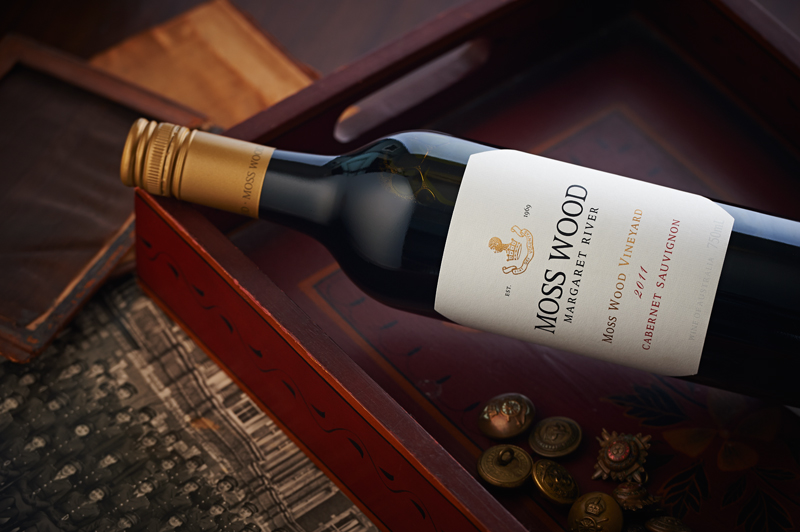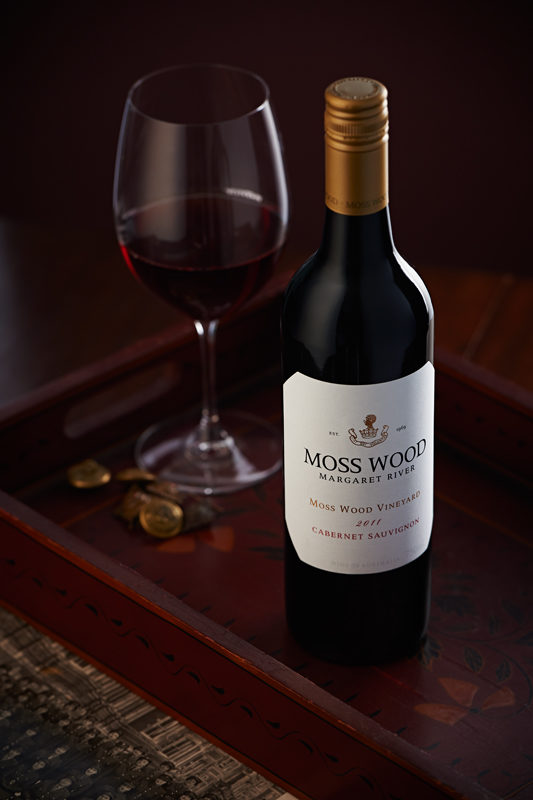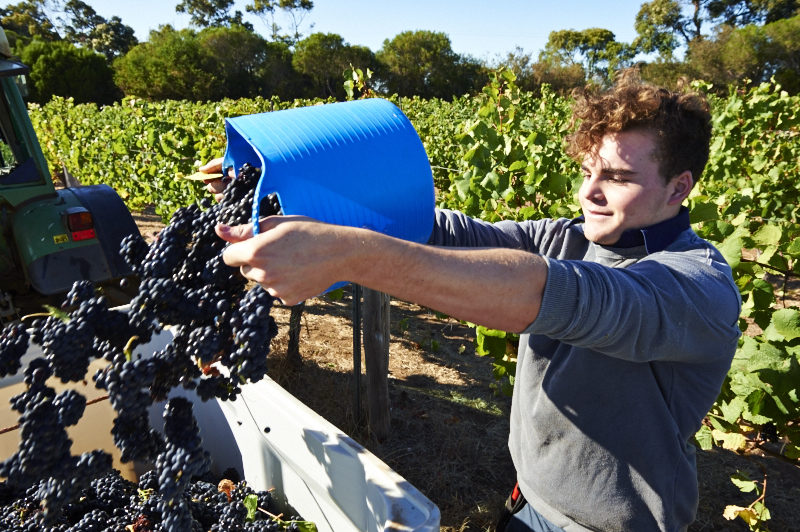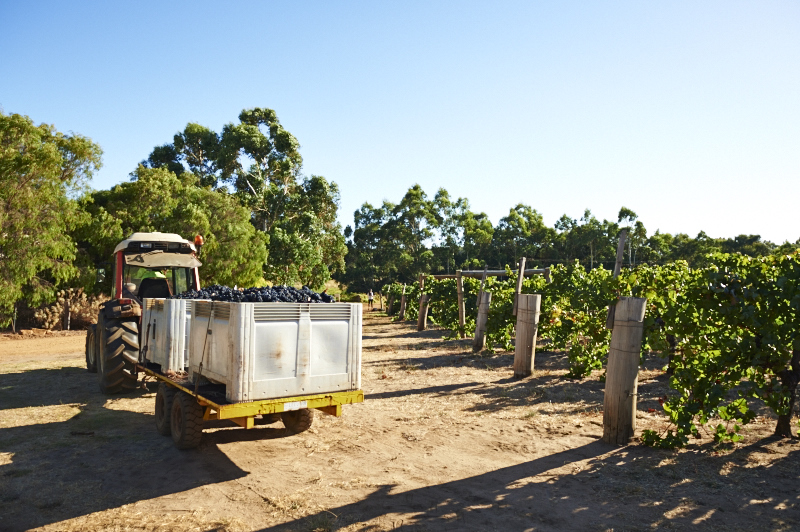Moss Wood Newsletter Autumn News Issue #85, April 2014
Moss Wood 2011 Cabernet Sauvignon

Moss Wood 2011 Cabernet Sauvignon
Vintage Notes
Let us make clear at the outset, the 2011 vintage at Moss Wood was extremely good, potentially great.
The point of this statement is to clear up any misconceptions that may have built up around the legend of the very difficult conditions experienced in south-eastern Australia for 2011. In those regions, with the notable exception of the Hunter Valley, the vintage was very difficult, largely because of the breaking of a decade long drought. Sometimes the tyranny of the distance of 4,000 kilometres works for us in a good way.
Our unfortunate colleagues on the other side of the country had to deal with very trying conditions, to say the least. As is always the case, the best grapegrowers and winemakers made a good fist of things and produced excellent wine but, generally speaking, the vintage has a poor reputation. Our point is not to draw attention to the problems of others but rather to make crystal clear that these conditions did NOT occur in Western Australia in general, and Margaret River, in particular.
And while we are on the subject, we definitely do NOT want to be seen as being smug because nothing could be further from the truth. Those of us who work in agriculture know and understand that our turn for a difficult season will come again. Mother Nature has a way of keeping us honest.
So, what did happen in 2011 at Moss Wood? It was a very good season, indeed, and provided more of the same on the theme of west coast Indian summers. Annual rainfall for calendar 2010 was 9% below average, at 880 millimetres. However, we continued to receive timely rain, right through Spring and Summer for a total of 183 millimetres across that period. In particular there were two very useful falls of 23mm and 32mm in the first and last weeks of January, respectively.
As is almost always the case, each variety had to deal with rain events around their flowering times and this produced a mixed outcome. Both Cabernet Sauvignon and Petit Verdot produced lower than average bunch weights but this didn’t reduce yield because they both also carried significantly more bunches per vine. Cabernet yielded 8.04 tonnes per hectare, 6% above average, Petit Verdot produced 7.22 tonnes per hectare, a mighty 12% above average. Cabernet Franc had the worst of the weather and its yields were down by 17% to 5.33 tonnes per hectare.
Although rain can disrupt our fungicide spray program, we managed to keep things on track for 2010/11 and we had no disease concerns.
Up until the end of January, the temperatures had been warm but not too hot.
According to the thermometer, 2011 was in very good company at that point with an average temperature across the season of 19.35ºC, almost exactly the same as the mighty 2001 at 19.37ºC. Mother Nature then decided to turn up the wick and from 15th to 28th February we had a succession of days with maxima in the mid-30’s. On the 26th we had the hottest day of the Summer when the mercury peaked at 39.2ºC. To put this in perspective, we went on to record our warmest February since 1998, with an average temperature of 23.76ºC, compared to the average over the same period of 21.21ºC.
Naturally enough, this kicked the ripening along and so harvesting for each of the varieties was early. The median harvest date for Cabernet Sauvignon was 12 days earlier than average on 15th March. Not all of this was a product of a warm February - it was partly a result of flowering being 4 days early, while the period from then until harvest was 8 days early. Petit Verdot was similar, with its harvest date of 19th March being 9 days ahead of average after flowering 5 days early. As is often the case, Cabernet Franc responded differently and despite flowering 7 days early, it was only 4 days ahead of average harvest date. Perhaps it ripened relatively more slowly because it had a tendency to shut down under the pressure of the heat?
We’re not sure but there are some parts of the vineyard where the gravel content is high and very free draining. In those sections, it’s quite likely the vines have less soil moisture making it more difficult for them to keep photosynthesising on very warm days.
Cabernet Sauvignon achieved 13.4º Baume, slightly above its long term average of 13.2º. On the other hand, both Petit Verdot and Cabernet Franc achieved flavour ripeness at slightly lower Baumes. The former was picked at 12.3º, compared to the typical 12.9º and the latter came in at 12.8º, compared to its 13.4º average.
Importantly, the maximum temperature did not soar into the 40’s and so the vineyard avoided extreme heat stress and the accompanying poor composition and loss of flavour.
This is best shown by a closer look at the temperatures. The vines experienced 1010 hours in their preferred range of 18 – 28ºC, 6% above the typical 952 hours. Little wonder they got to full sugar ripeness 8 days faster than usual. Similarly, they received plenty of warmth to drive out green fruit characters. There were 86 hours above 33ºC, 51% above the average of 57 hours.
With such good numbers, vintages like these can be deceptively easy and 2011 was a classic for this. Apart from keeping a weather eye on any rain that might be looming, we at Moss Wood just sat back in awe and watched the vines do their thing, marching inexorably towards harvest. Our job was to sample effectively and make sure we completed our side of the bargain by picking the fruit at optimum ripeness, capturing the best flavours. Needless to say, there are no excuses if we don’t.

Production Notes
Median Harvest Date:
Cabernet Sauvignon – 15th March, 2011
Petit Verdot – 19th March, 2011
Cabernet Franc – 1st March, 2011
Harvest Ripeness:
Cabernet Sauvignon – 13.4º Baume
Petit Verdot – 12.8º Baume
Cabernet Franc – 12.3º Baume
Our production process begins with the picking and regular readers of the Moss Wood newsletter will be fully aware that all our grapes are harvested by hand into small buckets. The fruit is loaded into bins and delivered to the winery where it is destemmed into small, open fermenters. At this point, each batch is seeded with a pure yeast culture for the alcoholic fermentation and once this is underway, the tanks are hand-plunged up to four times per day. The refrigeration system is set to maintain the ferment temperature at a maximum of 28ºC. After about 5 days, the fermentation is approaching “dryness” and each batch is tasted at least once per day to monitor the tannin balance and decide when pressing should be carried out. In 2011, the wines had good balance and so skin contact was relatively short - Cabernet Sauvignon spent 12 days on skins, Cabernet Franc spent 10 days and Petit Verdot spent 12 days. Each batch was pressed to stainless
steel tanks and underwent malolactic fermentation. After completion, all batches were analysed and acidity and sulphur dioxide adjusted and then racked to 225 litre French oak barriques.
In January 2012 the wine was racked and blended in stainless steel. The final blend consisted of 91% Cabernet Sauvignon, 6% Petit Verdot and 3% Cabernet Franc. The wine was then returned to barrel and received two more rackings, the first in January 2013 and then the final one in October 2013, when it was racked to stainless steel in preparation for bottling.
Various fining trials were then carried out but none of them improved the wine, so it was not fined. The wine was sterile filtered and bottled on 19th November, 2013.
Tasting Notes
Stylistically, we tend to see 2011 as a slightly brighter, riper version of the 2010 vintage, in the same way that 1991 was compared to 1990. This being the case, we put the 2011 right at the top of our quality echelon. It comes down to a matter of style preference to differentiate this cluster of wines, at the very top of which sits the 2001. Is the new vintage a genuine challenger? The short answer is yes, especially for those who prefer wines where bright fruit characters are the dominant component. Perhaps the purists would still go for 2001 with its complexities. Either way, it’s a close run thing.
Colour and condition:
Deep brick red; bright condition.
Nose:
Very scented; red fruit aromas of red currant and pomegranate; dark fruit aromas of blueberry and mulberry; floral, ethereal notes of violets, spice, dried herbs and red currant jelly; a background of tar, liquorice, seaweed, earth and cedar.
Palate:
Immediate impact of vibrant fruit flavours – red currant, black currant, rich, long and generous; full body; great length and breadth; very silky tannin gives the wine density and concentration but with excellent balance and leaves a smooth texture; soft, tarry oak notes on the finish.
Cellaring:
The fruit depth and balance of this wine is such that it has tremendous, immediate appeal and can certainly be enjoyed now and over the next five years.
However, purists need not fear because we also strongly recommend it for cellaring for at least 15 years, by which time the tannins will have softened a little and there will be some evidence of the bottle bouquet. To allow the wine to reach final maturity and display its full array, it should be cellared for 25 years.
Vintage 2014
To the time of writing, the 2014 vintage has been one of below average yields but very pleasing quality. All the whites are now finished and the Chardonnay, Semillon and Sauvignon Blanc are
showing terrific fruit aroma and balance.
It’s not that the low yields took us by surprise. Quite the contrary, in fact. The damage from the bad hail storm at the beginning of December 2012 was expected to suppress yields for at least 2 years but things were exacerbated by some very windy conditions during Spring 2013. For the varieties harvested so far, Chardonnay continues to confound, having produced a yield only 1% below average and Pinot Noir wasn’t too bad, down 6%. Sauvignon Blanc was down 12% but our two Semillon blocks fared worst of all – Moss Wood down 48% and Ribbon Vale 53%.
Everything else about 2014 has been good to us. The Redgum blossom has been plentiful, so the birds have left us alone. Our fungicide spray program has worked well and controlled disease.
Finally, and most importantly the quality question. A quick look at the temperatures reveals things have been very good for ripening. Up to the end of February, we had experienced an average across the growing season of 20.04ºC, making it one of the cooler seasons of the last decade and very similar to 2010. Mean temperature for the month of February was, coincidentally, 20.04ºC and the coolest since 2006. This does not mean the weather has been cold. Far from it, in fact because we’ve enjoyed a succession of days with a temperature range of the order of 12º to 28º. Apart from being very liveable for human beings, it suits the vines as well.
Vineyard Practices, Footprints and Wine Quality

Sustainability is a word that’s bandied around in agricultural production quite a lot these days and consumers, quite rightly, are concerned about the authenticity and safety of their food. In the 21st century, any well run vineyard is managed with an eye to being as sustainable as possible. The aim is to employ techniques designed to ensure minimum damage to the environment while at the same time producing high quality grapes, at reasonable cost.
In support of this aim, there is a multitude of tools for vineyard managers to choose from across a broad range of philosophies. At one end of the spectrum are growers who believe in the benefits of Steiner’s Biodynamic system, to those at the other end, who prefer to use techniques based on modern science.
Importantly, no matter what system people choose, the aim, in the end, is to achieve the outcome outlined above.
At Moss Wood, we fall firmly within the latter category and are happy to update an improve our vineyard and its sustainability, based on the evolution of science.
It is fashionable to talk about a vineyard’s footprint and there is a tendency for people to produce throw away lines like “the only footprint a vineyard should leave are your footprints”, or similar. If only it were that simple.
Regardless of which management system is chosen to run a vineyard, there is a significant issue that looms large whenever this concept is debated. Every year, a large part of the vineyard’s annual production, the crop, is taken away in the form of the finished wine, and with it go nutrients that can’t be replaced unless they are brought in from outside. This means that a vineyard management system, of any sort, is not and cannot be sustainable in itself.
On one hand, the major nutrient which leaves any vineyard in the form of grapes or wine is of course water, and to a greater or lesser extent, this is replaced naturally from the sky. However, in locations where rainfall is insufficient, vineyard managers quite rightly use irrigation as a supplement to reduce, or eliminate, any shortfall. However, access to and use of water is a very emotive debate in Australia and diverting water courses or accessing other sources of water can leave a very significant foot print. The question is, can this be justified? Typically, the answer is yes, although almost always with qualifications.
Most of the minor nutrients need to be topped up by inputs from outside the vineyard. The degree to which this takes place depends on the nutrient in question but to illustrate the point let’s use the example of Nitrogen. It is possible to provide an on-site supplement, at least to some degree, by growing legumes, usually as cover crops between the vine rows. This will go some way to maintaining a minimum level of nitrogen in the soil. However, these plants also compete for soil moisture, so must be managed carefully to ensure they don’t diminish the crop they are planted to enhance, especially in unirrigated vineyards such as Moss Wood and Ribbon Vale. It could also be said that if the legume is not a species native to the local environment, then its cultivation in itself will also leave a footprint.
Grapegrowers therefore need to turn to external sources. Traditionally, these are mineral fertilisers that are cheap to buy and are easily applied, at carefully calculated rates that meet the plants’
minimum requirements. Or, they may use mulches and composts from different sources – organic winery waste, for example. Since mulches and composts are natural products, their composition will vary, meaning application rates of the individual nutrients are less accurate. They do, however, have the attraction of bringing other benefits by enhancing things like soil microflora and structure. The point here is not to debate the merits of these different choices and typically a combination of both is used, but rather to point out that, once again, there is a footprint here, no matter which choice is taken.
We have reached this point without giving any consideration to the often vexed question of disease control but we hope this helps clarify, at least to some degree, how confusing a concept sustainability is. In fact, a strong argument can be made that without a series of outside interventions, which will invariably leave a footprint, no vineyard can be viable in the long term. Perhaps the key is to make as soft a footprint as possible.
Sustainability, Grey Water and Having a Laugh

Sustainability is, of course, a serious topic but it doesn’t mean we can’t have a laugh, so we thought we’d share one. An amusing statistic about wine production is how many litres of water we use – for every litre of wine we produce, we use roughly two litres of water. We hasten to add this is not water that finds its way into Moss Wood wine. Definitely not! However, we use large volumes of water for the cleaning work that a safe and relatively sterile environment requires.
All our basic wash-down water, used primarily for cleaning floors, is filtered from our spring-fed dam. Any water used for cleaning surfaces that come in contact with juice and wine are washed down with sterilefiltered rainwater.
In the name of sustainability and caring for the environment, the subsequent “grey” water is captured in holding tanks, the solids are settled (and eventually removed to be used in commercial mulch) and then it is pumped away to irrigate the winery compost. The system is generally easy to operate and fuss free and keeps our grey water out of the local creeks. While it is not toxic in any way, the sedimentation tanks can get a bit smelly and this will cause a nuisance if our main pump breaks down, as it recently did.
To solve the problem, the tanks were drained, leaving an ankle-deep residue on the bottom and then the recalcitrant submersible pump was retrieved and examined.
The lucky tradie assigned to the job, let’s call him Gus, checked the pump, concluded that it seemed to be OK, returned it to the tank and leaned over the top to watch it operating again. Unfortunately, his brand new wallet dropped out of his top pocket and plopped into the smelly remnants at the bottom of the tank. Typically this is the fate of mobile phones, but not on this day. Needless to say, this led to a stream of profanities, only slightly less in volume than Keith’s laughter. Gus tried desperately to retrieve said wallet using a length of fencing wire, but to no avail. There was no choice – he had to get a ladder and climb down to fetch it. This was done absolutely according to confined space entry but there was a small problem. When he got to the bottom, he slipped! More profanity and more laughter followed but he safely exited the tank, with the wallet but let’s just say, he didn’t come up smelling of roses.
Order
OUR WINES:
Contact
MOSS WOOD:
Location: 926 Metricup Road, Wilyabrup WA
Postal: PO Box 225, Cowaramup WA 6284
Phone: +61 8 9755 6266
Fax: +61 8 9755 6303
Follow us on
SOCIAL MEDIA:
